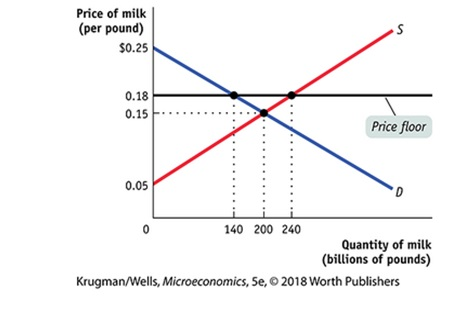
In 2014, U.S House of Representatives approved a farm bill establishing the margin protection program (MPP) for dairy produces. The MPP supports dairy farmers when the margin between feed cost and milk prices falls below $0.08 per pound. Current feed cost is $0.10 per pound, which means the program creates a prices floor for milk at $0.18 per pound. At the price, in 2015 the quantity of milk supplied is 240 billion pounds, and the quantity demanded is 140 billion pounds. To support the price of milk at the

- The
consumer surplus andproducer surplus created in the absence of floor price and also calculate the total surplus. - When the floor price is $0.18, and the consumers buy 140 billion pounds of milk, calculate the amount of consumer surplus
- When the floor price is $0.18, and the producers sell 240 billion pounds of milk, calculate the producer surplus
- The money spent by the USDA to buy surplus milk
- The total surplus when there is a floor price and how does the total surplus compare to the total surplus without a floor price
Concept Introduction:
Consumer Surplus:
Consumer surplus is the difference between the maximum amount the consumer is willing to pay for a good and the amount the consumer actually pays.
Producer Surplus:
The producer surplus is the difference between the amount that a producer receives and the minimum amount the producer is willing to accept to part with the good. In other words, the producer surplus of a firm is the sum over all units produced of a difference between the market price and the marginal cost of production.
Total Surplus:
Total surplus is the sum of consumer surplus and producer surplus.
Floor Price:
It is a government-imposed price control or limits on the minimum price that can be charged for a product. A floor price must be higher than the market price to be effective.
Want to see the full answer?
Check out a sample textbook solution
Chapter 5 Solutions
Loose-leaf Version for Microeconomics in Modules
- As indicated in the attached image, U.S. earnings for high- and low-skill workers as measured by educational attainment began diverging in the 1980s. The remaining questions in this problem set use the model for the labor market developed in class to walk through potential explanations for this trend. 1. Assume that there are just two types of workers, low- and high-skill. As a result, there are two labor markets: supply and demand for low-skill workers and supply and demand for high-skill workers. Using two carefully drawn labor-market figures, show that an increase in the demand for high skill workers can explain an increase in the relative wage of high-skill workers. 2. Using the same assumptions as in the previous question, use two carefully drawn labor-market figures to show that an increase in the supply of low-skill workers can explain an increase in the relative wage of high-skill workers.arrow_forwardPublished in 1980, the book Free to Choose discusses how economists Milton Friedman and Rose Friedman proposed a one-sided view of the benefits of a voucher system. However, there are other economists who disagree about the potential effects of a voucher system.arrow_forwardThe following diagram illustrates the demand and marginal revenue curves facing a monopoly in an industry with no economies or diseconomies of scale. In the short and long run, MC = ATC. a. Calculate the values of profit, consumer surplus, and deadweight loss, and illustrate these on the graph. b. Repeat the calculations in part a, but now assume the monopoly is able to practice perfect price discrimination.arrow_forward
- how commond economies relate to principle Of Economics ?arrow_forwardCritically analyse the five (5) characteristics of Ubuntu and provide examples of how they apply to the National Health Insurance (NHI) in South Africa.arrow_forwardCritically analyse the five (5) characteristics of Ubuntu and provide examples of how they apply to the National Health Insurance (NHI) in South Africa.arrow_forward

 Principles of Economics (12th Edition)EconomicsISBN:9780134078779Author:Karl E. Case, Ray C. Fair, Sharon E. OsterPublisher:PEARSON
Principles of Economics (12th Edition)EconomicsISBN:9780134078779Author:Karl E. Case, Ray C. Fair, Sharon E. OsterPublisher:PEARSON Engineering Economy (17th Edition)EconomicsISBN:9780134870069Author:William G. Sullivan, Elin M. Wicks, C. Patrick KoellingPublisher:PEARSON
Engineering Economy (17th Edition)EconomicsISBN:9780134870069Author:William G. Sullivan, Elin M. Wicks, C. Patrick KoellingPublisher:PEARSON Principles of Economics (MindTap Course List)EconomicsISBN:9781305585126Author:N. Gregory MankiwPublisher:Cengage Learning
Principles of Economics (MindTap Course List)EconomicsISBN:9781305585126Author:N. Gregory MankiwPublisher:Cengage Learning Managerial Economics: A Problem Solving ApproachEconomicsISBN:9781337106665Author:Luke M. Froeb, Brian T. McCann, Michael R. Ward, Mike ShorPublisher:Cengage Learning
Managerial Economics: A Problem Solving ApproachEconomicsISBN:9781337106665Author:Luke M. Froeb, Brian T. McCann, Michael R. Ward, Mike ShorPublisher:Cengage Learning Managerial Economics & Business Strategy (Mcgraw-...EconomicsISBN:9781259290619Author:Michael Baye, Jeff PrincePublisher:McGraw-Hill Education
Managerial Economics & Business Strategy (Mcgraw-...EconomicsISBN:9781259290619Author:Michael Baye, Jeff PrincePublisher:McGraw-Hill Education





